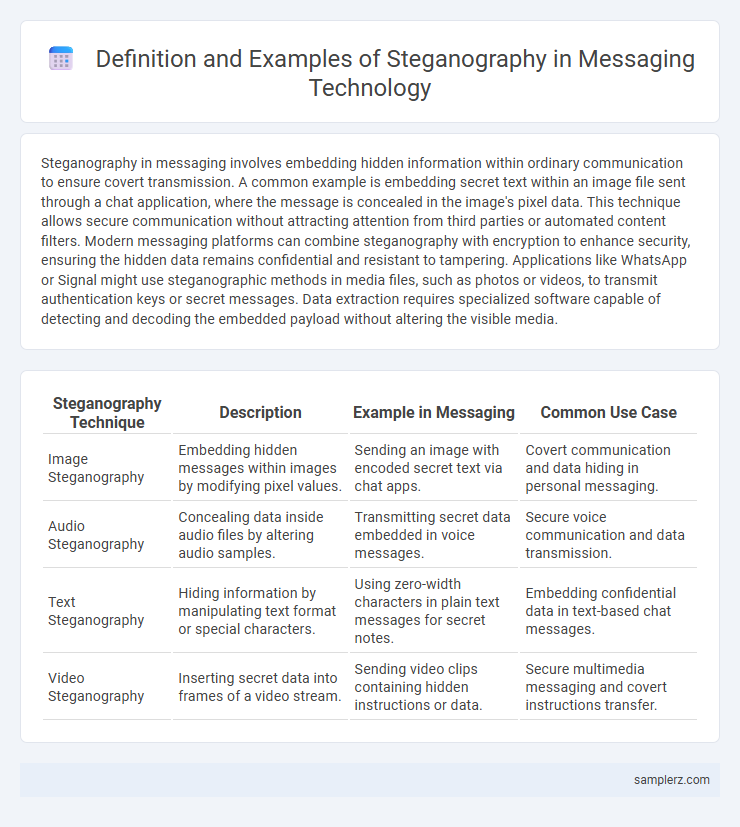Steganography in messaging involves embedding hidden information within ordinary communication to ensure covert transmission. A common example is embedding secret text within an image file sent through a chat application, where the message is concealed in the image's pixel data. This technique allows secure communication without attracting attention from third parties or automated content filters. Modern messaging platforms can combine steganography with encryption to enhance security, ensuring the hidden data remains confidential and resistant to tampering. Applications like WhatsApp or Signal might use steganographic methods in media files, such as photos or videos, to transmit authentication keys or secret messages. Data extraction requires specialized software capable of detecting and decoding the embedded payload without altering the visible media.
Table of Comparison
| Steganography Technique | Description | Example in Messaging | Common Use Case |
|---|---|---|---|
| Image Steganography | Embedding hidden messages within images by modifying pixel values. | Sending an image with encoded secret text via chat apps. | Covert communication and data hiding in personal messaging. |
| Audio Steganography | Concealing data inside audio files by altering audio samples. | Transmitting secret data embedded in voice messages. | Secure voice communication and data transmission. |
| Text Steganography | Hiding information by manipulating text format or special characters. | Using zero-width characters in plain text messages for secret notes. | Embedding confidential data in text-based chat messages. |
| Video Steganography | Inserting secret data into frames of a video stream. | Sending video clips containing hidden instructions or data. | Secure multimedia messaging and covert instructions transfer. |
Exploring Steganography: Concealing Messages in Plain Sight
Steganography in messaging utilizes techniques such as embedding hidden text within digital images or audio files, allowing secret communication without arousing suspicion. Common examples include using least significant bit (LSB) manipulation in images or subtle alterations in audio waveforms to encode confidential information. These methods enhance privacy and security by concealing data within ordinary files that appear innocuous to unintended recipients.
How Steganography Enhances Messaging Security
Steganography enhances messaging security by embedding secret information within ordinary digital files like images, audio, or video, making the presence of hidden messages undetectable to unauthorized users. Techniques such as Least Significant Bit (LSB) substitution modify pixel values in images to conceal data without noticeable changes, ensuring covert communication. This method protects messages from interception and decryption by combining cryptography with concealment, reinforcing overall data privacy in digital messaging platforms.
Common Methods of Steganography in Modern Messaging
Common methods of steganography in modern messaging include embedding hidden text within image pixels using least significant bit (LSB) manipulation, concealing data in audio files through echo hiding or phase coding, and utilizing protocol steganography by inserting covert messages into unused header fields of network packets. These techniques allow secure communication without altering the perceptible quality of the media, making detection challenging. Advances in encryption combined with steganographic methods enhance confidentiality and privacy in digital message transmission.
Real-World Examples of Steganographic Messaging Techniques
Steganographic messaging techniques frequently appear in digital communication, such as embedding secret texts within image pixels on social media platforms or hiding messages in audio files shared via instant messaging apps like WhatsApp. One notable example is the use of least significant bit (LSB) modification in images, where hidden messages remain imperceptible to human eyes yet retrievable with specialized software. Cybersecurity researchers also identify steganographic methods in covert channels within encrypted messaging services, illustrating real-world applications of this technology for secure, undetectable communication.
Image-Based Steganography: Hiding Messages in Photos
Image-based steganography embeds secret messages within digital photos by altering imperceptible pixels or color values, ensuring the hidden data remains undetectable to the naked eye. Techniques like least significant bit (LSB) modification enable encoding of textual or binary information directly into image files without significantly affecting visual quality. This method is widely used in secure messaging platforms and digital watermarking to covertly transmit confidential information embedded in standard image formats such as PNG or JPEG.
Audio Steganography: Embedding Secrets in Voice Notes
Audio steganography embeds secret messages within voice notes by manipulating inaudible frequencies or slight variations in audio signals, ensuring covert communication without degrading sound quality. This technique uses methods like least significant bit (LSB) modification and phase coding to conceal data efficiently within digital audio files. By integrating encrypted information into voice notes, audio steganography enhances privacy in messaging applications and protects sensitive data from unauthorized access.
Text Steganography: Invisible Messages in Plain Text
Text steganography embeds secret messages within ordinary text by manipulating fonts, spacing, or introducing subtle character variations, enabling covert communication without raising suspicion. Techniques such as zero-width characters, invisible ink Unicode, or slight alterations in letter formatting conceal information in digital messages. These methods allow secure data transmission over public channels while maintaining the appearance of normal, readable text.
Steganographic Tools for Secure Messaging Applications
Steganographic tools such as OpenPuff and SilentEye enable users to embed hidden messages within digital files, enhancing security in messaging applications. These tools utilize techniques like least significant bit (LSB) manipulation to conceal text within images or audio files, making the communication imperceptible to unauthorized parties. By integrating steganography with encryption protocols, secure messaging platforms reduce the risk of interception and data breaches.
Detecting and Preventing Steganography in Messaging Platforms
Detecting and preventing steganography in messaging platforms involves advanced algorithms that analyze patterns in image, audio, and text files to identify hidden data. Techniques such as deep learning-based anomaly detection and statistical analysis of message payloads help uncover covert communication channels embedded within media files. Implementing real-time monitoring and encryption protocols ensures the integrity and security of messaging services against steganographic attacks.
The Future of Steganography in Digital Communication
Emerging steganography techniques will embed encrypted data within multimedia files to enhance privacy in digital messaging platforms. Advances in AI-driven algorithms enable more sophisticated hiding methods, making unauthorized detection increasingly difficult. This evolution promises secure, covert communication channels critical for protecting sensitive information in future digital interactions.

example of steganography in messaging Infographic
 samplerz.com
samplerz.com